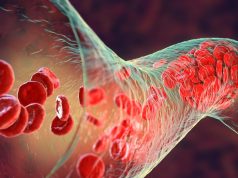Deep learning of ECG waveforms and clinical variables used to create fusion algorithm that may predict likelihood of pulmonary embolism
MONDAY, Jan. 3, 2022 (HealthDay News) — A model integrating clinical data with electrocardiogram (ECG) waveforms may improve prediction of pulmonary embolism (PE), according to a study recently published in the European Heart Journal-Digital Health.
Sulaiman S. Somani, M.D., from the Icahn School of Medicine at Mount Sinai in New York City, and colleagues created a retrospective cohort of 21,183 patients at moderate to high suspicion of PE, with 23,793 computed tomography pulmonary angiograms (10.0 percent positive for PE), 320,746 ECGs (12.8 percent positive for PE), and encounter-level clinical data. To predict PE likelihood, three machine learning models were developed: an ECG model using only ECG waveform data, an electronic health record (EHR) model using tabular clinical data, and a Fusion model integrating clinical data and an embedded representation of the ECG waveform.
The researchers found that the Fusion model outperformed both the ECG model and EHR model (area under the receiver operating characteristic curve [AUROC], 0.81 ± 0.01 versus 0.59 ± 0.01 and 0.65 ± 0.01, respectively). The Fusion model also achieved greater specificity (0.18) and performance (AUROC, 0.84 ± 0.01) than four commonly evaluated clinical scores on a sample of 100 patients (Wells’ Criteria, Revised Geneva Score, Pulmonary Embolism Rule-Out Criteria, and 4-Level Pulmonary Embolism Clinical Probability Score [AUROC, 0.50 to 0.58; specificity, 0.00 to 0.05]).
“We provide the first integration of raw ECG waveforms and show that it improves outcome prediction,” the authors write. “This is a novel finding and suggests that further work must be done to identify relevant clinical features our deep learning models are identifying from ECGs that otherwise remain indiscernible to clinicians.”
Several authors disclosed financial ties to the biopharmaceutical and medical technology industries.
Copyright © 2021 HealthDay. All rights reserved.








